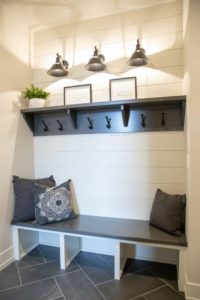Kitchens of the Future
How to be more eco-friendly in the heart of your home
The “go green” movement has taken residence in our home-improvement vernacular, as companies and homeowners try to find ways to use sustainable, more energy-efficient materials and appliances for their new or remodeled kitchens.
LED lighting, quartz countertops, recycled-glass tile backsplashes, cast-iron sinks, and bamboo, cork and recycled-tile flooring are all ways you can help make your kitchen a more eco-friendly gathering place, explains Judy Kimble, corporate director of sales and marketing with First Supply/K&B. However, the term “greener” can cover a variety of interpretations.
“‘Greener’ kitchens mean different things to different people,” she explains. “For example: composting versus the use of garbage disposals, to cork floors, to giving up plastic wrap, to buying local organic vegetables, etc.”
Industry stakeholders like Kimble say that while more eco-friendly products and materials exist, it’s not often a path chosen by homeowners in northeastern Wisconsin. Kimble cites a 20 to 30 percent increased cost for a green build as one of the limiting factors.
“When it comes to the world of using sustainable products, specifically in terms of kitchen design, we do not see a trend for ‘greener’ kitchens,” she says of northeast Wisconsin. “The reality is, there are not many sustainable products used in a new or remodeled kitchen.
“Do we all wish to contribute to making the world environmentally better? I think we do,” Kimble adds. “However, many ‘green’ products cost more, aren’t available or accessible.”
 Cost factor and availability are issues that Richard and Misty Hermanson, of VKB Homes in Menasha, have come across in their business as well. Often, to find cost-effective, more eco-friendly materials for kitchen renovations—like countertops—sourcing has to occur in larger cities outside of the Fox Valley, explains Misty, who is VKB Homes’ creative design specialist.
Cost factor and availability are issues that Richard and Misty Hermanson, of VKB Homes in Menasha, have come across in their business as well. Often, to find cost-effective, more eco-friendly materials for kitchen renovations—like countertops—sourcing has to occur in larger cities outside of the Fox Valley, explains Misty, who is VKB Homes’ creative design specialist.
“We had a client who wanted [terrazzo] and it was four times the cost of what a high-end quartz is, so you’re talking $4,000 for a 4 by 8 [foot] slab of that product. Even though we do have high-end remodels, that’s a lot of money, when you’re talking a kitchen-size [slab].
“Another problem with a lot of those products is the size of the material. You can’t get large material, so you have to have seams and cuts and a lot of people don’t want that in their countertops.”
In terms of the construction materials, VKB Homes’ president and founder Richard says he believes there is one company manufacturing steel studs out of refurbished or recycled material, but materials like that are few and far between.
“It’s not readily available and because of that, there isn’t a high demand,” he explains. “So, there isn’t a high supply and the prices are really high.”
That’s not to say there isn’t an effort with businesses, like VKB Homes, to be as green as possible internally with their methods during the building and renovation process. Misty says they work with companies that are as eco-friendly as they can be, like Delta, while trying to stay within a good price point. They also encourage clients to reuse material, whether it’s cabinetry or old countertops. While the homeowner may not want the materials anymore, donating material to places like Habitat ReStore or recycling it among friends and family is always encouraged.
“I truly think that we are mindful builders, in the fact the companies we use are reputable and the materials last a long time,” she furthers. “We used to be in the industry of buying and flipping homes; if you put junk products in the home, they’re going to have to redo it in a year or two and where does that material go? It goes right into the dump. Longevity is eco-friendly, too.”
Making “green” their mission
Prestige Custom Cabinetry and Millwork is one northeastern Wisconsin company attempting to do their part in changing the availability of more eco-friendly kitchen components. Mike Mashl established the business in 1992 and has now made “going green” a central focus of Prestige’s mission. As sales and marketing manager Angel Mashl explains, Prestige tries to make less of an environmental impact through shop recycling programs, the use of certified materials, and by using low volatile organic compound (VOC) finishes and more environmentally friendly glues.
 “I think what is really important in this market is people use high-quality cabinets and that way they have to replace them less,” she says. “Our wood comes from a very high-quality, sustainable forest in Pennsylvania. We don’t get any of our wood from overseas.”
“I think what is really important in this market is people use high-quality cabinets and that way they have to replace them less,” she says. “Our wood comes from a very high-quality, sustainable forest in Pennsylvania. We don’t get any of our wood from overseas.”
While cabinetry from Prestige may come at a higher cost than big-box competitors, people may be getting more than they bargained for when they buy less expensive cabinets from overseas, in terms of inferior material and components used.
“I think they need to be better aware of where their products come from,” explains Mashl. “If they do come from overseas, chances are they don’t have a high standard as far as watching emissions, recycling programs and the formaldehyde and other [chemicals] that go into those products.”
A more seamless starting point: appliances
Appliances are one area of the kitchen where energy efficiency has been embraced over the last several years.
“Energy efficiency has been a focus for the appliance industry for many years,” says Jesse Tweed, sales professional with Van Vreede’s in Appleton. “Our government, through standards, has pushed manufacturers along to meet those standards—like flow rates in faucets.”
Another big development in the last decade has been the concept of the “connected home,” where appliances are connected to smartphones and other devices, and can even anticipate your usage in advance.
“The connected home, the connected appliance, is without a doubt the direction this industry is going,” says Tweed. “The Jetsons are 100 percent here and they’re only going to get bigger.”
Refrigerators, for example, are not only extremely energy efficient, but part of the connected home technology has been the creation of the “learning” refrigerator, he states. The refrigerator has the ability to anticipate high usage and prepare for it.
“The storing temperature is at 37 degrees all night long, but the fridge starts to know that at 7 a.m. the temperature is going to raise a fair amount because of your activity in it—making breakfast, getting ready for school, grabbing lunches, etc. So it preemptively cools itself a bit, knowing that it is going to warm up.”
There are a good number of brands now that are also implementing variable speed compressors, he says. Whereas that ol’ beer fridge in the garage may be a single-stage compressor, which is either on or off, the variable speed compressor runs at a certain percentage as needed to maintain temperature, making them more energy efficient and a lot quieter.
Technology has also made the dishwasher a more eco-friendly appliance. Tweed says dishwashers have been energy-efficient for a number of years. A normal cycle uses sub-four gallons of water, whereas a normal kitchen faucet flows at 2.2 gallons per minute. A German company, Miele, has taken their effort in energy efficiency a step farther. They use a double helix to reuse the hot water heated by the dishwasher as it’s extracted, to then in turn warm the fill line of the water going in.
 And it doesn’t stop there with appliances: ovens are getting an upgrade, too. If you don’t already have one, induction cooktops are soon to be our future.
And it doesn’t stop there with appliances: ovens are getting an upgrade, too. If you don’t already have one, induction cooktops are soon to be our future.
“If you buy an appliance, and it’s an electric version, it’s most likely going to be an induction,” Tweed says. “For the consumer, it kind of checks almost all of the boxes. It’s very energy efficient and wherever you’re at in the life spectrum, it’s very safe. It’s very utilitarian, it’s easy to use, it’s extremely responsive and it’s easy to clean up.”
Take the first step toward a better tomorrow
No matter how far you choose to delve into the world of sustainable, eco-friendly products, whether it’s a new fridge or a whole kitchen renovation, we can all do our part by starting with small steps to limit the carbon footprint we leave behind for the tomorrows ahead.
“I think it’s just the right thing to do for the future,” adds Mashl. “There is a focus on it and if we can help control our products and byproducts a little better, why not?”










Leave a Comment